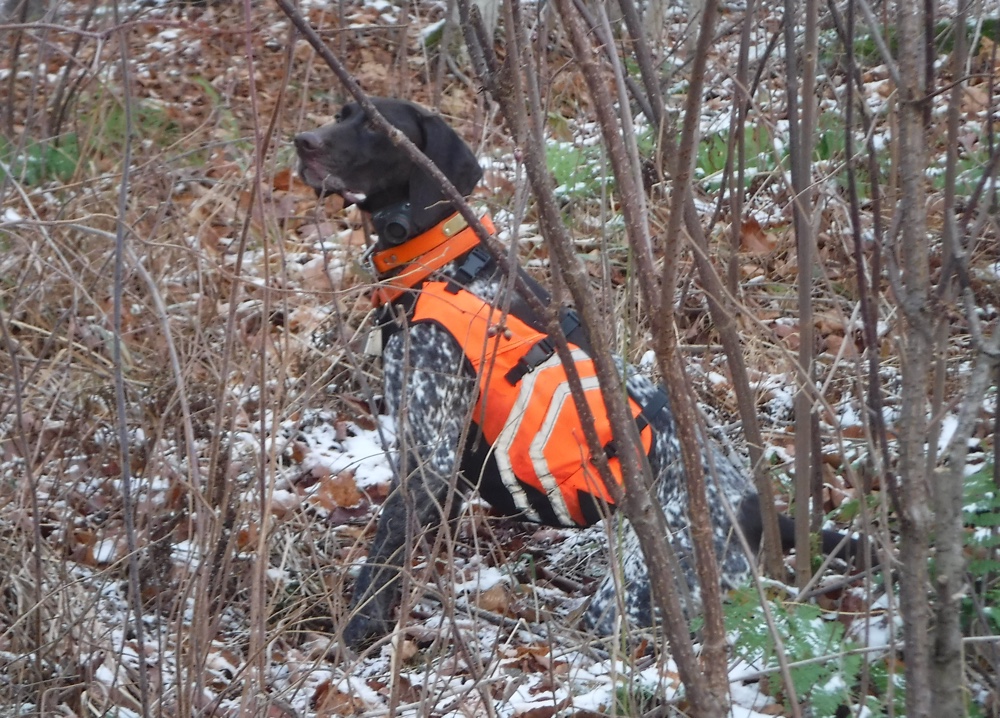
By the Numbers
Please keep in mind that this analysis is of the statistics to this point in the season - it does not include any hunting that I might do from here until December 31. The numbers have been compiled with clients of all ages (ranging from young to old) and experience levels in grouse hunting. For some, their first experience hunting the Gray Ghost was with me this year, while other clients already had an impressive resume of grouse hunting. Shooting abilities and physical limitations also played a part in these numbers. As you probably know by now, those that can walk farther for longer will probably see more grouse than those walking the roads ... especially after the birds have gotten some pressure along the edges.
Season Totals
Our NH coverts got a lot more attention this season than our Vermont areas (138.0 hours to 27.5), as would be expected, but the bird finding seemed to be better in the granite state than Vermont. A major reason might be that most of our better woodcock coverts are located in NH, which can skew the numbers, particularly in October.
We moved a total of 575 birds in 31 days of hunting. Of those, 463 were grouse, making the remaining 112 woodcock. That averages out to 14.93 grouse moved per day (a 40% increase from 2019), and 3.61 woodcock seen per day, which is a sizable drop from the number we hit last year. We generally hope to move about 20 birds a day, so we might've been a bit lower in our average this year, but it is, after all ... hunting.
Our best day of encountering grouse this year was 29 moved, on October 5. Our lowest total was a modest 5, encountered on November 3, a day after a lingering snowstorm dumped 4-5" of snow in the uplands. We worked hard for them that day ...
On the woodcock, we had several good days, with the best being October 8, when we moved 14 woodcock. There were several other solid timberdoodle finding days too, but it seemed that the season ended prematurely on them. The vast majority were gone from our area by the end of October, as chilling temperatures and several different snow falls moved them out, ahead of the typical schedule.
As you might expect, the best hunting and bird finding seems to be in the first two weeks of the season. For one, there's a lot of young and inexperienced birds still around, and this year the shooting chances were there too, as our foliage dropped early. Our best day was 32 birds total between grouse and woodcock on October 5, but we had quite a few great days in the first two weeks of the season. We wish we had more throughout the season, but that's how grouse hunting is sometimes.
Bird finding opportunities became much more difficult over the last couple weeks of the season. Not only were the woodcock gone, but our changing (and challenging) weather made things difficult. Also, the natural attrition of the hunting season on the first year birds meant that we were hunting grouse experienced in eluding hunters and dogs alike, and it showed.
Grouse & Woodcock Hunting by the Week
Week 1 (10/1 - 7): 180 birds moved (31% of the season total). 156 grouse, 24 woodcock. Took 7 grouse, 4 woodcock.
Week 2 (10/8 - 14): 139 birds moved (24%). 96 grouse, 43 woodcock. Took 6 grouse and 8 woodcock.
Week 3 (10/15 - 21): 56 birds moved (10%). 33 grouse, 23 woodcock. Took 1 grouse, 3 woodcock.
Week 4 (10/22 - 28): 96 birds moved (17%). 74 grouse, 22 woodcock. Took 1 grouse, 6 woodcock.
Week 5 (10/29 - 11/4): 83 birds moved (14%). 83 grouse. Took 4 grouse.
Week 6 (11/5 - 9): 21 birds moved (4%). 21 grouse. Took 1 grouse.
Reading in to the numbers, it's apparent that the first two weeks of the season were great for us. Not only did we find a lot of birds, but my clients also had some good chances on them as the early leaf drop helped mightily. With the prevalence of young grouse and woodcock, we had a better than average number of sticking points by the dogs, resulting in a better kill rate (25 of the 41 birds we took this season were in the first two weeks of October).
Conversely, the latter two weeks of the season were tougher as our cold and snowy weather got the woodcock on the move earlier than normal. The woodcock finding was pretty steady through much of October however. In short, the grouse numbers were definitely better this year than most years, and woodcock numbers were mostly average, at least for our gang.
The Performance of the Dogs
Rosie (4 yrs): 8 grouse & 10 woodcock taken
Bode (7 yrs): 5 grouse & 3 woodcock taken
Monty (10 yrs): 5 grouse & 5 woodcock taken
Rosie and Bode got the bulk of the work, in an attempt to keep the pressure off Monty and while all of the dogs did really well this season, with great cooperation and many points, Rosie continued showing that she's a true grouse and woodcock specialist. She had some really amazing days out there this year. Bode had many solid sessions as well, quite a few of which went unrewarded. While Monty didn't run as much as the younger dogs, he made his time count in the grouse woods - he proved that he's still a great grouse finder ...
The remaining five birds were either taken over clients's dogs or without the aid of a dog (wild flushes). I wish I had statistics of points from all of the dogs, but there's simply no way to do it without losing sight of the big picture (getting clients in to position to take a safe shot). Rosie would probably have led in this category as well.

